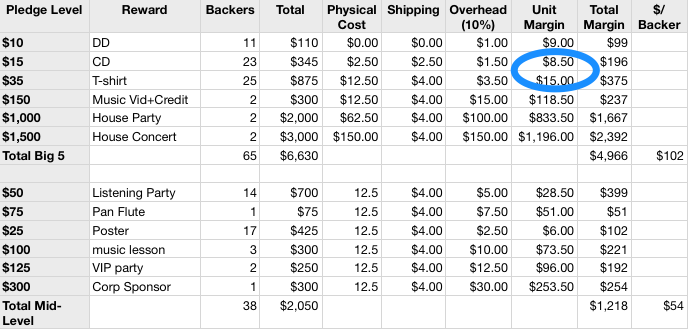 When you submit your projects, we really do look at them!
When you submit your projects, we really do look at them!
Today’s subject: Appalatin from Louisville, KY, who recently sent their project in to us.
The good news: these guys successfully funded within their first week!
They obviously know a thing or two about Purpose Worth Backing and connecting with their Circle of Influence. (Of course they do, they read L&R!)
They also mentioned taking our advice on rewards to heart by employing the Big 5 plus paying specific attention to mid-level packages. That being said, I would like to use their palette of rewards to point out a key consideration in creating rewards: pricing.
Purpose Worth Backing = Story + Objectives
Appalatin’s “unique fusion of cultural musical styles” is one that is bound to attract some support.
They play lots of shows “through community organizations and other grass roots networks”.
When this is the case, there is usually ample access to local patrons of the arts who are more than thrilled to support your cause… as long as you have one.
We feel we developed a compelling story and very clearly defined objectives with our project. Our special purpose and use of the funds is clearly outlined in the project description and in the video. We also feel that the bi-lingual delivery of our project video made a great impression. ~ Steve Sizemore of Appalatin
That pretty much says it all.
Develop a compelling story and clearly define your objectives.
Double Check Your Rewards Pricing
These guys are doing great, so I don’t want to be too critical here. However, this is a good opportunity to talk about what happens on the back end of a successful project.
You have to be certain that your rewards pricing will leave money for everything: the project, physical rewards, shipping, and overhead like Kickstarter fees. Otherwise, you might be in for a thousand dollar surprise, and NOT in a good way!
For every project reviewed in 2013, Levi and I have completed a rewards analysis spreadsheet in which we look carefully at the rewards created for the project plus their margins and the total amount of funding left for your project after accounting for overhead and reward fulfillment.
In analyzing Appalatin’s rewards, I noticed that their physical CD and T-shirt rewards left a smaller margin than you might expect. Let’s take a quick look!
This table makes some basic assumptions about the cost of creating physical CDs and T-shirts as well as the cost to ship. It also assumes an overhead to Kickstarter of 10%. Each of these costs should be estimated on the high end so that there aren’t any surprises. Appalatin’s costs may be a bit less (and hopefully not more)!
So, do you notice anything?
The first thing I notice is that the margin on a physical CD is very close or even less than the margin for a Digital Download.
Second, I notice that the margin for a T-shirt and CD is only $15.00. That means that when a backer pledges $20 extra dollars (moving from $15 to $35), the band only ends up with another $6.50.
Isn’t that something?
Now, Appalatin may have excellent reasons for pricing their rewards in this manner.
Perhaps they have T-shirts that are already paid for sitting in their garage. This will change the math in their favor.
Or perhaps they feel really strongly about getting their CD out there in hopes that it will expand their fan base. This is perfectly justifiable.
Or perhaps they are just willing to kick in a little extra for shipping a such. At this point, they are at 150% of their goal, so it won’t matter anyways!
But the final point here is that you need to be aware of the math. Make sure that your rewards pricing reflects your situation and constraints.
Note: Kickstarter suggests pricing very close to real world value. We believe this for some project types such as design or fashion but for music, we have seen that backers are typically much more supportive than the average fan.
They are not only willing, but they WANT to help you fund your project. Because of this, they are often willing to pay a premium over and above the real world value of an item.

Leave a Reply